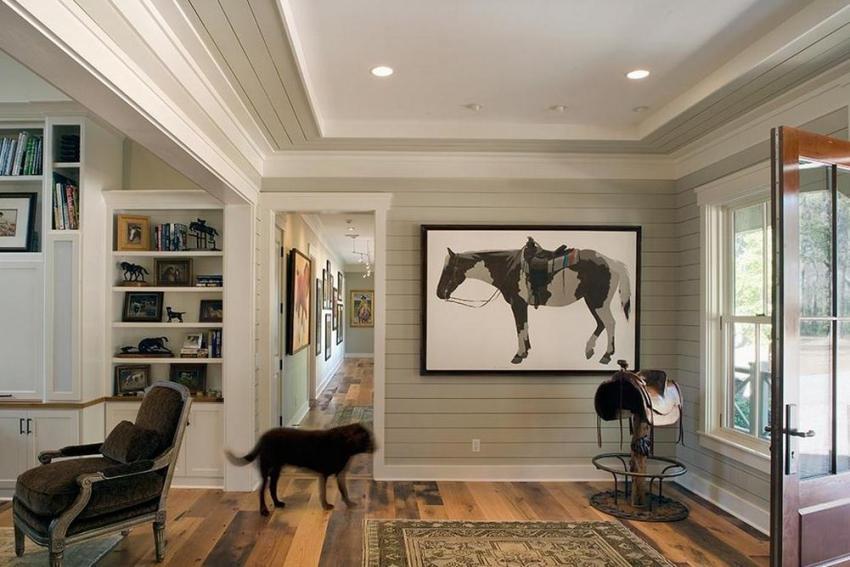
The dry plaster mixture is added to water and mixed using the mixer of the construction
- As part of the plaster is dominated by gypsum. The ability of this mineral matter fasten quickly allows you to use this type of plaster on the ceiling and in other places with difficult access.
Related article:
|
Today, there are few who can prepare plastering mixture of the individual ingredients. In commercially available ready-made dry compositions that are sufficiently diluted with water according to the instructions and mix thoroughly. Mixing can be done with a drill with an attachment.
The solution is to plaster walls, proportions: video instruction
Useful advice!With self-preparation of the plaster mixture is necessary to consider the brand of cement. The higher it is, the more sand is required. It provides better adhesion of PVA glue that can be added to the solution.

Tools that may be required for self-plastering walls with cement mortar
Video plaster the walls with his own hands with cement mortar: preparatory work
Plastering the walls with his own hands cement mortar necessarily includes preparations. If this is new construction and has a wall of a conventional ordinary brick, the great need in their preparation for application of plaster mix there. It is only necessary to cut down with an ax protruding bricks, if any exist. This will help avoid applying too thick layer unnecessarily.

Slurry first jumped on the wall using a trowel, then the mixture is uniformly distributed rule
If the walls are made of facing brick, then you need to hammer a nail between the rows and bind all the aluminum wire. Even better would be to fix the plaster grid. The wall itself should be primed and put it on the tile adhesive with a spatula with teeth. Only then can be applied to the mixture. Concrete, gas concrete blocks and also require a priming and adhesive application. Special plaster grid will help make high-quality plaster on such walls. Otherwise mortar rebound from them.

Applying the plaster cement mixture on the wall
Wooden wall plaster is much more difficult. To do this, be sure to secure them from the crate racks or ready-made grid, sold in stores. You should also perform a primer.

For plastering walls typically used length 1.5 - 2 m
In the case of repair work in front of the preparatory work necessary to make a complete dismantling of the old coating to the core. If the walls remain of the old plaster, the quality of new jobs can not be guaranteed. Presented on any video plaster the walls with his own hands, always begins with the preparatory work, the quality of which depends on the success of the repairs.
Useful advice! Too dry walls do not allow the mixture to stick. Therefore, before plastering is necessary well to wet bricks.
Algorithm plastering walls
As in any construction process, for plastering walls has its own specific rules and workflow. To apply the plaster on the prepared brick wall, you must:
- Mounted on the wall plaster mesh using driven into staggered dowels. The mesh should have a corrosion resistant coating. Otherwise, there will be traces of rust on the wall prior to complete drying of the plaster. Dowels are interconnected binding wire Z - shaped patterns.

Scheme optimal placement of beacons wall
- Apply plaster mix and leveled on beacons.
- Produced smoothing plaster.
The process of applying a mixture of very long and laborious. The solution ties into the wall with a trowel or bucket, as anyone convenient. Throwing motion must be done from the bottom-up. It is necessary to fill the space between two adjacent beacons. Then special rule align the deposited mixture. Thus ends the tool must slide up the bottom-surface profiles.

One of the complex processes for plastering the walls with his own hands - decoration of the interior angles. To make the task easier - you can use homemade angular level of building profile
In the process of this movement usually need sharp movements to move left and right. This allows you to evenly distribute the solution on the wall, compacting it. The result is a smooth wall. After completing the first segment, we pass on to the next. All movements are repeated. In the video, the plaster walls on beacons with their hands can be seen in detail, which movements are made rule.

An example of the construction of the lighthouse fixing to the wall
When the walls a little dry out, they need to wipe. For this purpose poluter board or trowel. These tools are moved over the surface in a circular motion. The process continues as long as the surface is smooth. If the plaster has had time to dry out too much grout, it is possible to moisten.

Grout half wet plaster is performed using polutera
To obtain a smooth surface without cracks, it is necessary to strictly control the drying process. Firstly, higher temperatures in the room are not allowed. Secondly, the walls must be periodically moistened with water. Third, you should always immediately overwrite the cracks. Proper drying control ensures high-quality plaster.

By wetted in water solution does not stick instrument that facilitates plastering
Useful advice!During the entire operation the instrument should be moistened with water. This will prevent the adhesion of the solution that will accurately and competently perform plastering surface.

When plastered walls dry out - you can proceed to their spackling
Although the procedure applying the plaster on the walls is a time-consuming and unpleasant, the quality of its performance should not be in doubt. Irregularities on the walls do not allow to make beautiful finish registration or be forced to take additional measures to equalize, which would entail additional costs.



